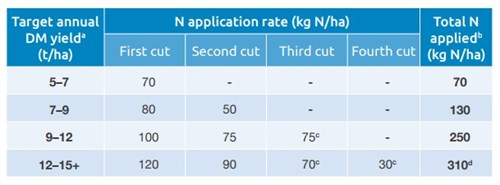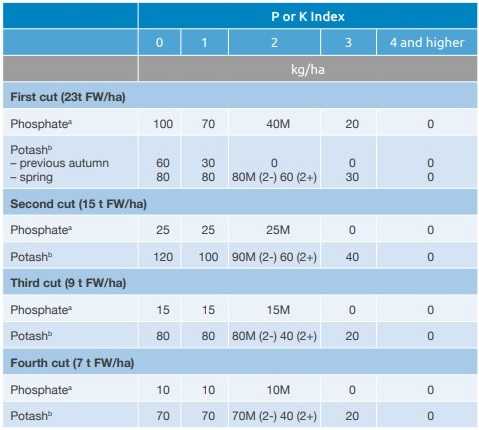Preparing for multi-cut systems
Friday, 3 April 2020
Farmers are encouraged to review their nutrient management plan to optimise grassland productivity and to ensure desired silage yield and quality are met this harvest season.
With the movement towards more frequent cutting, referred to as a multi-cut, first cut will be around the corner for some farms. Now is the time to review your post-cut fertiliser application plan and to ensure these are available for application within the first week post harvesting.
Strategic application of nitrogen (N) fertiliser will help stimulate grass growth. This will be most effective on swards with a high proportion of perennial ryegrass, as this species use N more efficiently than other grasses. Too much N produces grass with low sugar levels and any resulting silage can have high ammonia and butyric acid levels, making it less palatable. Too little N compromises yield and protein levels can be low. N recommendations for grass silage cuts are detailed in Table 1. Further information on nitrogen management and recommendations can be found in Section 3: Grass and Forage Crops of the Nutrient Management Guide (RB209).

Table 1: Nitrogen recommendations for grass silage (Source: Nutrient Management Guide (RB209), Section 3, p15)
For Phosphate (P) and Potash (K) recommendations, the results of a recent soil analysis showing the soil Index will be needed. Fields regularly cut for silage have a higher requirement for P and K due to the high removal of these nutrients by the crop. For example, a 30 per cent dry matter (DM) silage contains 2.1kg of P and 7.2kg of K per tonne of fresh material. The addition of K is particularly important to maintain grass yields. P and K recommendations for grass silage are detailed in Table 2. Further information on P and K recommendations can be found in Section 3 of the Nutrient Management Guide (RB209). At soil indices 2+ or below, catch up K is needed. It is recommended in a three-cut system an extra 30kg K/ha to be applied after cutting.

Table 2: Phosphate and Potash recommendations for grass silage (Source: Nutrient Management Guide (RB209), section 3, p10)
Due to the reduction in industrial emissions of sulphur (S), deficiency is increasingly common in grassland, especially in later cuts of a multi-cut system or where high rates of N are used. The symptoms of S deficiency are indicated by yellowing of the youngest leaves. As well as reducing grass yield, sulphur deficiency affects N uptake and the formation of protein in the plant.
Soil testing does not provide an adequate indication of levels of S in soil. Analysis of the sward just before cutting is a useful indicator of deficiency and can be used to assess the need for S for future cuts. The plant requires sulphur during the growing phase and therefore it’s too late to address a deficiency close to harvest but it can help address deficiency in future silage cuts. A concentration of less than 0.25 per cent total S, or an N:S ratio greater than 13:1 in the grass dry matter indicates S deficiency.
Soils more at risk of sulphur deficiency:
- Sandy shallow soils
- Loamy and coarse-silty soils in areas with >200 mm rainfall between November and February
- Clay, fine silty or peat soils in areas with >400mm rainfall between November and February
On soils at risk of sulphur deficiency apply 40 kg SO3 /ha before each cut.
Points to consider:
- Choosing the right time for application is key, as grass responds best to N when soil temperatures measured at 10cm is higher than 5.5°C for at least four consecutive days.
- Organic manures should be applied at least six weeks before silage making to avoid contamination that leads to fermentation problems.
- Ensure you allow enough time for the plants to utilise N applied from manures and inorganic fertiliser. Grassland can utilise 2.5kg N/ha/day (around 2 units of N/acre/day) under ideal weather conditions.
- As with all nutrient planning, an up-to-date soil test is vital to allow the most effective and cost-effective use of fertilisers and manures. Test your soils every 3-4 years is best.
For further information on nutrient applications visit AHDB Nutrient management guide (RB209) and the BRP manual Managing Nutrients for Better Returns.
Topics:
Sectors:
Tags:

